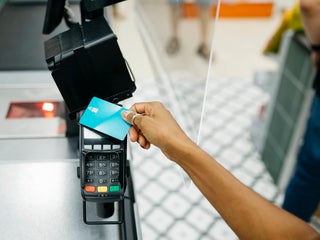Summary
Learn how digital transformation enmeshes finance with other industries, then read experts’ thoughts on the credit card marketing landscape today and where it might be heading in 2019 and beyond.
The content on this page is accurate as of the posting date; however, some of our partner offers may have expired. Please review our list of best credit cards, or use our CardMatch™ tool to find cards matched to your needs.
Digital transformation has had a huge impact on the financial and banking industry — not only in how money is managed via digital channels or by restyling financial services but also by providing new business models to other industries.
The transformation also affects credit card marketing trends, which have been changing due to necessity.
First, learn how digital transformation enmeshes finance with other industries, then read experts’ thoughts on the credit card marketing landscape today and where it might be heading in 2019 and beyond.
1. Card companies might have to offer more personal finance management tools to compete
Credit card issuers now find new competitors among innovative companies.
For example, Apple recently went into banking with the Apple Card.
Made in partnership with Mastercard and Goldman Sachs, the Apple Card promises to improve the way Apple Wallet works, said Michael Kelley, director of communications for the iOS app development company Fueled.
On top of earning cash back credit with the Apple Card, consumers will have a clearer idea of where the money they spend goes, thanks to color-coded purchases.
Another feature that tags retailers and purchasing locations is designed to serve as a built-in money manager to help users improve their financial health.
Apple is among the first to recognize how financial technology interlaces with everything else, and it’s raising the bar for new credit card trends that will include collaborative partnerships, creating brand loyalty cards and promoting a cash back reward system, Kelley said.
“In the surge of competition, it’s a challenge for finance companies to reach out and acquire new or keep existing customers — it is becoming increasingly important to understand what works as marketing in 2019 and beyond,” Kelley said.
See related: New Apple Card: Innovative features, but are the rewards worth it?
2. Marketing will likely be getting more personalized
Beverly Harzog, credit card expert for U.S. News & World Report, expects that credit card marketing to existing customers will become more personalized.
“For example, I get emails from my credit card issuers that use my first name and offer me a very low APR on an existing card for a period of time, new short-term category rewards or even loan offers.
“Issuers know that it’s cheaper to hang onto a current customer than it is to bring in a new one,” she said.
Harzog also thinks the credit card marketing landscape will have to evolve to accommodate applications via mobile devices.
“We’re already becoming a society that uses smartphones to manage our finances,” Harzog said.
And that means credit card issuers will have to make sure that applications on mobile devices are easy to understand and complete — a good user-friendly design that encourages the consumer to complete the application instead of giving up in frustration.
“The increasing number of consumers who want to apply for a credit card on a mobile phone must be provided a simple and enjoyable experience,” Harzog added.
Joe Lawlor, co-founder and chief marketing strategist for the Las Vegas-based marketing agency Digital Dynasty, agrees that marketing is becoming more personalized.
He feels credit card marketing is becoming age-specific and is being distributed to target age groups through YouTube and Facebook ads.
This type of marketing is cost-effective, and because of that, Lawlor said, we’ll soon start to see even more pinpointed ads.
For example, ads that target people who love watching sports will be shown to that audience only.
The same goes for groups such as stay-at-home moms, corporate business people, local business owners and others, Lawlor noted.
“The waste on ad spend for irrelevant audiences is slimming down, particularly in businesses that have high marketing budgets like credit card companies,” Lawlor said.
3. Marketing might expand to more subprime customers
Chane Steiner, CEO of Crediful, expects card availability to expand significantly in 2019.
Credit card issuers are beginning to advertise to a larger percentage of people who would be considered subprime, he said.
The reason for this is changes in the metrics that determine credit eligibility, Steiner noted.
FICO will be launching its new UltraFICO program, which is expected to bring in a lot of people who wouldn’t normally qualify, Steiner added.
“Also take into consideration the expansion of VantageScore, which uses different metrics from FICO, and I expect to see a lot more credit card applications being approved in 2019,” Steiner said.
The reason we are seeing this expansion is because VantageScore is much more inclusive for students and other people who might not use credit often.
Whereas FICO requires a full six months of credit scoring, VantageScore takes into account the very first month.
“This, combined with the fact that VantageScore considers data such as rental payments, public records and utility bills, means that many more people are able to be brought into the credit rating system,” Steiner said.
4. Direct-mail offers for cards might decline
According to the research firm Mintel, applications originating from direct mail campaigns have declined a bit.
This trend could continue because consumers can hop online and apply for credit cards without dealing with the hassle of finding a stamp, Harzog said.
“Direct mail isn’t going away, but issuers will bow to what is convenient for their customers, which means using more digital marketing and making the user interface as easy as possible,” Harzog added.
According to MediaPost, although consumers prefer direct over electronic mail (especially in underserved areas), they are still most likely to apply for a credit card on a website or via their mobile phones.
In fact, 33 percent of them will use a smartphone to apply, and desktops (29 percent) and tablets (11 percent) come in second and third.
The study also showed that 13 percent of credit card offers are made on card issuers’ websites, 10 percent are delivered via third-party websites, 6 percent by mobile apps and 6 percent through social media.
See related: Credit card offers no longer flooding your mailbox? Here’s why
5. Affiliate and third-party collaboration marketing could ramp up
If you can’t create new business value from features everyone in the industry has, you can capitalize by following other industry examples, Kelley feels.
Brand-related credit cards — such as those that offer Uber points — can get even more attractive for consumers, due to their relative value for users’ priorities.
Interest is still an important factor, but it can be overshadowed by newly created partnerships between general-purpose credit card issuers and brands with which consumers have established relationships — and whose rewards they could benefit from in the long-term.
In a way, this is a personalized services trend, which Harzog said is likely to happen in the credit card market.
It follows the general path toward using newly acquired data to learn more about customer needs — and being able to meet them in more sophisticated ways.
“Because consumers are likely to attach to a credit card provider by incentivization from brand discounts and points at major online and local retailers, affiliate marketing and collaborative partnerships are the ways to go,” Kelley said.
Third-party websites are important revenue generators, but they are currently underused, he added.
And Kelley understands that, because he said that finance requires careful treading forward.
“But it also deserves innovation,” he said.
See related: 7 ways to attract targeted credit card offers
The wrap-up
Companies across the board are adopting digital transformation, making it competitive to capture consumers’ attention.
But marketing is already getting more personalized, and now even subprime consumers are target audiences.
Direct mail campaigns are slowing down because although consumers like it more than electronic mail ads, they are still likely to actually apply for a credit card digitally.
Experts agree that credit card marketing needs to evolve and open up even more to finding new value in sharing and collaboration.
Editorial Disclaimer
The editorial content on this page is based solely on the objective assessment of our writers and is not driven by advertising dollars. It has not been provided or commissioned by the credit card issuers. However, we may receive compensation when you click on links to products from our partners.



